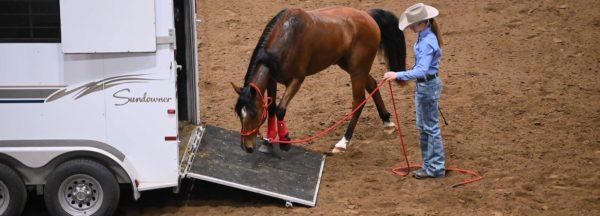Training Tip: Trailer Loading a Blind Horse

Question: My horse is blind in one eye. We finally got him to go in the trailer, but when we went to tie him up, he freaked out. What do you suggest for me to do so I can get him in the trailer and for him to stay still when he’s in there? We tried groundwork to get him in and that didn’t work—someone had to clap behind him and then he jumped in. – weeone
Clinton’s Answer: I would forget about teaching your horse how to stand quietly in the trailer right now and instead focus on earning his respect and trust and establishing a partnership with him. As a general rule, I do not treat horses that are blind in one eye any differently than I do horses that have perfect eyesight. I’ve found that I’ve only had to make alterations to two exercises—Roundpenning and Lunging for Respect.
In both of those exercises, if you go to do a rollback on the horse’s blind side, he won’t be able to see you step out in front of him to cue him to turn in and go in the other direction. So I give the horse a verbal cue. At the same time that I step, I say, “turn, turn, turn.” The horse learns that when I say, “turn,” it means do a rollback.
When I go to yield the horse’s hindquarters to bring him up to me, I make a shushing sound. What your horse really needs you to do is teach him the Fundamentals level of the Method. He needs a leader, and you need to be able to communicate with him in a way that he understands. You’ll find that once you take him through the Fundamentals groundwork exercises, he’ll be calmer and more responsive.
Then you can work on getting him to load in the trailer and teaching him to stand quietly when he’s tied up. You’ll work on each of these issues separately to begin with. There are many resources in the No Worries Club website’s video library and on the Downunder Horsemanship app that will show you how to teach your horse to load in the trailer and the best practices to use to teach him to stand tied up.
When your horse can load in the trailer well and stand quietly when tied up, then you can work on teaching him to relax while he’s tied up in the trailer. There are no quick fixes in horsemanship. If you want your horse to be a safe, willing partner, you’ve got to educate yourself and put in the time necessary to train him.
Have a horsemanship question or looking for more training tips? Check out the No Worries Club.
